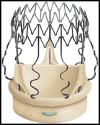International Expert Consensus on Sutureless and Rapid Deployment Valves in Aortic Valve Replacement Using Minimally Invasive Approaches
- PMID: 27540996
- PMCID: PMC4996354
- DOI: 10.1097/IMI.0000000000000287
International Expert Consensus on Sutureless and Rapid Deployment Valves in Aortic Valve Replacement Using Minimally Invasive Approaches
Abstract
Objective: To define the benefit of sutureless and rapid deployment valves in current minimally invasive approaches in isolated aortic valve replacement.
Methods: A panel of 28 international experts with expertise in both minimally invasive aortic valve replacement and rapid deployment valves was constituted. After thorough literature review, the experts rated evidence-based recommendations in a modified Delphi approach.
Results: No guideline could be retrieved. Thirty-three clinical trials and 9 systematic reviews could be identified for detailed text analysis to obtain a total of 24 recommendations. After rating by the experts 12, final recommendations were identified: preoperative computed tomographic scan as well as intraoperative transesophageal echocardiography are highly recommended. Suitable annular sizes are 19 to 27 mm. There is a contraindication for bicuspid valves only for type 0 and for annular abscess or destruction due to infective endocarditis. The use of sutureless and rapid deployment valves reduces extracorporeal circulation and aortic cross-clamp time and leads to less early complications as prolonged ventilation, blood transfusion, atrial fibrillation, pleural effusions, paravalvular leakages and aortic regurgitation, and renal replacement therapy, respectively. These clinical outcomes result in reduced intensive care unit and hospital stay and reduced costs. The use of sutureless and rapid deployment valves will lead to a higher adoption rate of minimally invasive approaches in aortic valve replacement. Respect should be taken to a necessary short learning curve for both sutureless and minimally invasive programs.
Conclusions: Sutureless and rapid deployment aortic valve replacement together with minimally invasive approaches offers an attractive option in aortic valve placement for patients requiring biological valve replacement.
Figures



References
-
- Leon MB, Smith CR, Mack M, et al. Transcatheter aortic-valve implantation for aortic stenosis in patients who cannot undergo surgery. N Engl J Med. 2010;363:1597–1607. - PubMed
-
- Vahanian A, Alfieri O, Andreotti F, et al. Guidelines on the management of valvular heart disease (version 2012): the Joint Task Force on the Management of Valvular Heart Disease of the European Society of Cardiology (ESC) and the European Association for Cardio-Thoracic Surgery (EACTS). Eur J Cardiothorac Surg. 2012;42:S1–S44. - PubMed
-
- Brown J, O‘Brien SM, Wu C, et al. Isolated aortic valve replacement in North America comprising 108,687 patients in 10 years: changes in risks, valve types and outcomes in the Society of Thoracic Surgeons National Database. J Thorac Cardiovasc Surg. 2009;137:82–90. - PubMed
-
- Reynolds MR, Magnuson EA, Wang K, et al. Health-related quality of life after transcatheter or surgical aortic valve replacement in high-risk patients with severe aortic stenosis: results from the PARTNER (Placement of AoRTic TraNscathetER Valve) Trial (Cohort A). J Am Coll Cardiol. 2012;60:548–558. - PubMed
-
- Zahn R, Gerckens U, Grube E, et al. Transcatheter aortic valve implantation: first results from a multi-centre real-world registry. Eur Heart J. 2011;32:198–204. - PubMed
Publication types
MeSH terms
LinkOut - more resources
Full Text Sources
Other Literature Sources

